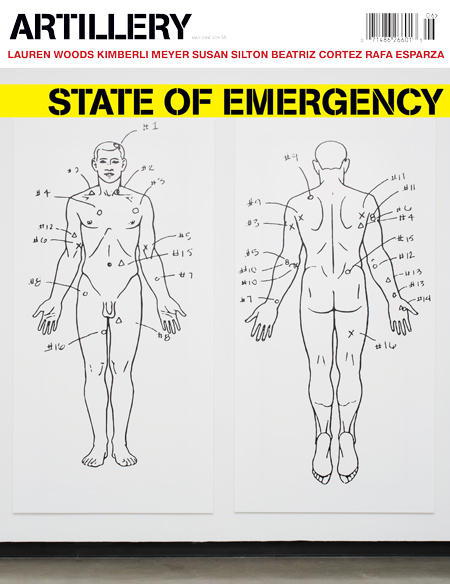Editor’s Letter for Artillery’s State of Emergency Issue
Tucker Neel, Guest GditorArtillery Magazine May / June 2019.
Dear Reader,
The philosopher Walter Benjamin wrote On The Concept of History in 1940 while fleeing the Nazi death machine and his words have never been more prescient: “The tradition of the oppressed teaches us that the ‘emergency situation’ in which we live is the rule. We must arrive at a concept of history which corresponds to this. Then it will become clear that the task before us is the introduction of a real state of emergency; and our position in the struggle against Fascism will thereby improve.” Given the many “states of emergency” today, both real and imagined, it’s convenient, perhaps reassuring, to focus on individual events while ignoring the systemic failings that allowed them to occur in the first place. What Benjamin calls for is a revolutionary articulation of the interconnectedness of all crises and catastrophes. Some of the things we call art and some of the people we call artists participate daily in this task, revealing and engaging the big Emergency behind isolated events, politicizing aesthetics to unmask, and undermine, fascism’s agents, agencies and agendas.
In this issue, Andrea Guerrero explores one such project with her profile on lauren woods’ American Monument, a prolific and devastating work of art addressing police brutality and the murder of people of color in America. To reinforce the agency and urgency of this project, woods’ collaborator Kimberli Meyer took the opportunity to use her curatorial spread to explain how you the reader can add to American Monument, help build an archive that sheds light on police killings obfuscated by bureaucratic obstinance and institutionalized racism.
Another avenue of approach is explored in Jennie Park’s analysis of the work of Beatriz Cortez and Rafa Esparza, whose individual and collaborative pieces touch on multiple issues, including impending environmental collapse, draconian border detentions, the power of indigenous knowledge, concepts of utopian extraterrestrial escape, as well as solutions for the problems that face us here on Earth.
On a much lighter note, Anthony Carfello’s second-person narrative presents a satirical take on art world narcissism, product placement, and conspicuous consumption. In contrast, Jessica Kehinde Ngo explores how art can instruct on and intervene in instances of food insecurity caused by historical injustice and climate change. Finally, we include Susan Silton’s newest body of work which uses newspapers from the 1930s and ’40s as shocking reminders of what might happen if we don’t remove the bigot-in-chief and all his sycophantic allies from office—permanently.
It wasn’t long ago I came very close to giving up on art, having little hope it could change this mess we’ve been in for a very long time, especially given the way a weaponized and fictionalized past always seems to rob the world of future justice and equality.
While I’m still realistically skeptical of claims that art can change the world, this issue of Artillery does give me more faith than when I began and renews my confidence in cultural production as one tool among many in the fight against fascism. Here’s hoping this issue does the same for you.
—Guest Editor Tucker Neel
©2024 Tucker Neel. All rights reserved.
